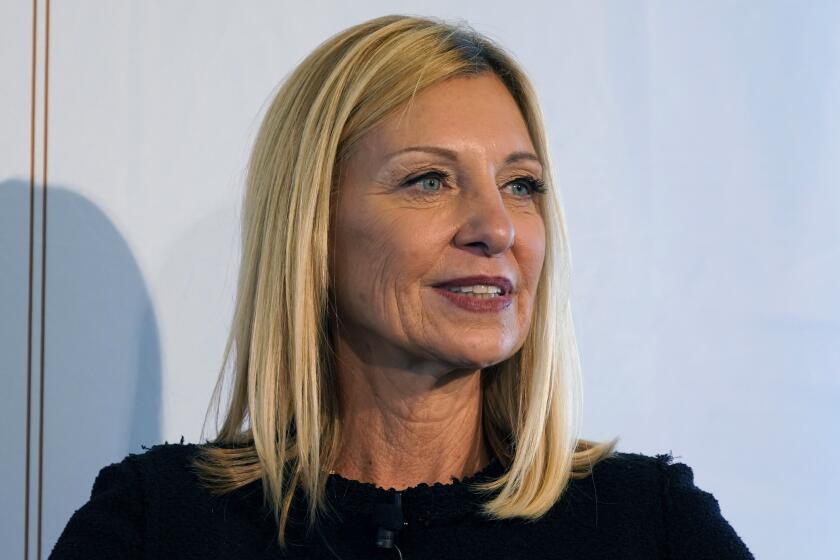Inflation Rate Rising Toward 5% : Fed Seen Hiking Interest Levels if Trend Continues
Consumer prices continued their steady upward march in October, the Labor Department reported Tuesday, advancing 0.4% and apparently locking the nation’s economy on a path toward a yearly inflation rate of 5%.
The October price report, as has been the case in recent months, was marked by temporary aberrations--in this case unusually high clothing prices and auto insurance and financing costs. But economists focused instead on the fact that the month’s increase in the consumer price index was pushing inflation to a point beyond what the Federal Reserve Board may be likely to tolerate.
“There are always some fluky things, like apparel prices in October,” said Bruce Steinberg of the Merrill Lynch investment firm in New York. “But the main thing isn’t any particular given item any more but the fact that we’re getting inflation at this rate month after month. . . . It’s getting to an area where the Fed will be uncomfortable.”
Wage Inflation Seen
Other analysts agreed. “We seem to be at a pace of consumer price inflation that will inevitably lead to increased wage inflation” and its consequences, said Roger Brinner of Data Resources Inc., a Lexington, Mass., economic forecasting firm. “And, as that happens, the Fed must be expected to react. (It) won’t want to live with 5% inflation.”
Economists said that they expect the Fed to move soon to push up interest rates in an attempt to slow the economy and curb inflation.
The largest single factor in the October inflation was a 1.8% increase in clothing prices, after a 2% jump in September. The steep increase, paced by women’s and girls’ apparel, resulted from what has become a twice-yearly ritual: high markups as fall and spring clothing styles first reach stores, followed by steep markdowns as consumer purchases decline and retailers announce winter and summer sales.
Auto Insurance Costlier
Auto insurance premiums rose more steeply than usual--up 1.4%--and auto finance charges jumped 3.4%, as dealers dropped their recent practice of concessionary financing to offset higher new-model car prices. Partly offsetting the sharp increase, new car prices rose only 0.1% after seasonal adjustment--considerably less than in recent years.
Other volatile factors included food and energy. With the effects of this year’s drought in the Farm Belt beginning to subside, decreases were reported for meat, fruit and vegetable prices. Food prices overall rose only 0.2%, after a 0.8% increase in September.
Energy prices were up slightly, by 0.1%, as sizable increases for electricity and natural gas more than offset a 1.1% drop for gasoline and a 3.2% drop for home fuel oil.
What is more significant, the cost of all consumer items other than food and fuel was up 0.5%, after a 0.4% increase in September. Medical care, a perennial inflation leader, also increased 0.5%, as did all services.
Economists cited the increases as a firm sign of higher inflation in the price index’s basic core categories and a strong sign that an upward trend is now under way.
Inflation Ratcheting Up
“We are on a trend where we are being ratcheted to higher” inflation, said Stacy Kottman of the Georgia State University economic forecasting project, which specializes in price movements.
He noted that, although consumer price inflation from October a year ago was 4.2%, the 10-month rate so far in 1988 has been 4.6%. The rate over the last three months has been 4.8%--a slow but steady rise. The October rate alone, compounded to an annual rate, would be 5.1%.
At some point, Brinner of Data Resources said, the Fed will decide that the economy is overheating and a slowdown will be engineered.
In the Los Angeles-Long Beach-Anaheim metropolitan area, consumer price inflation in October was 0.5% before seasonal adjustment, compared to a 0.3% nationwide unadjusted rate.
That nationwide increase left the index for all urban consumers at 120.2 points over its 1982-84 base of 100. This means that a basket of consumer goods that averaged $100 between 1982 and 1984 would have cost $120.20 in October.
More to Read
Inside the business of entertainment
The Wide Shot brings you news, analysis and insights on everything from streaming wars to production — and what it all means for the future.
You may occasionally receive promotional content from the Los Angeles Times.










